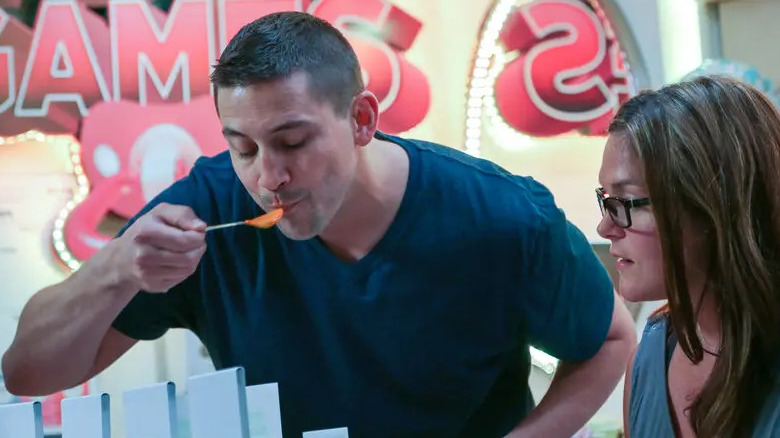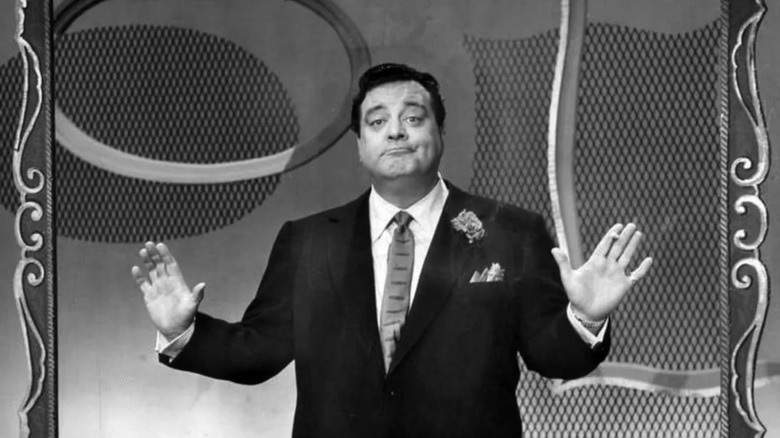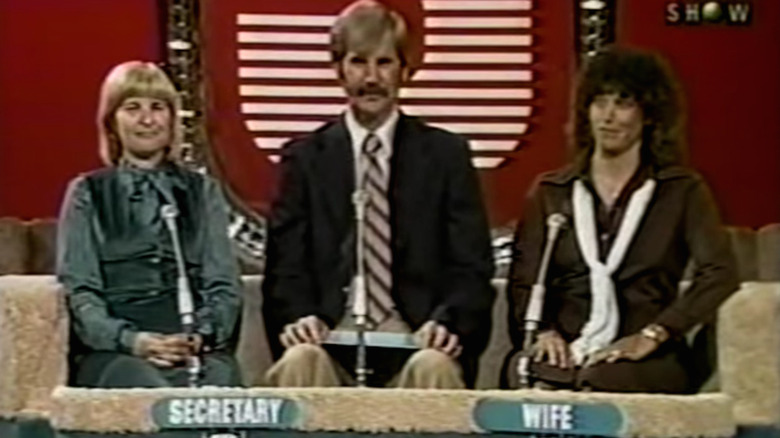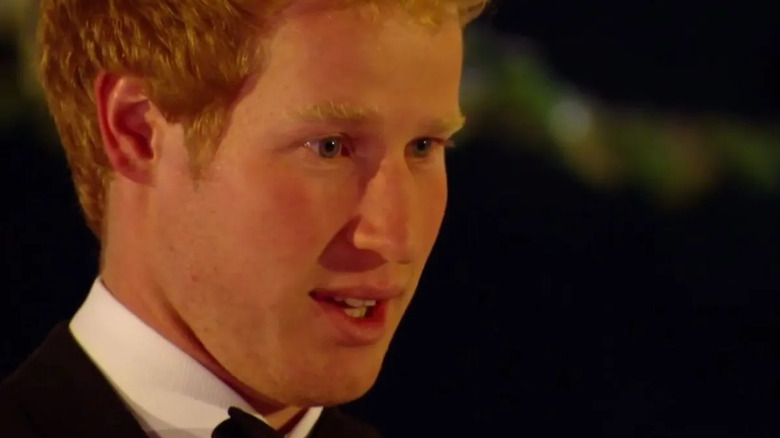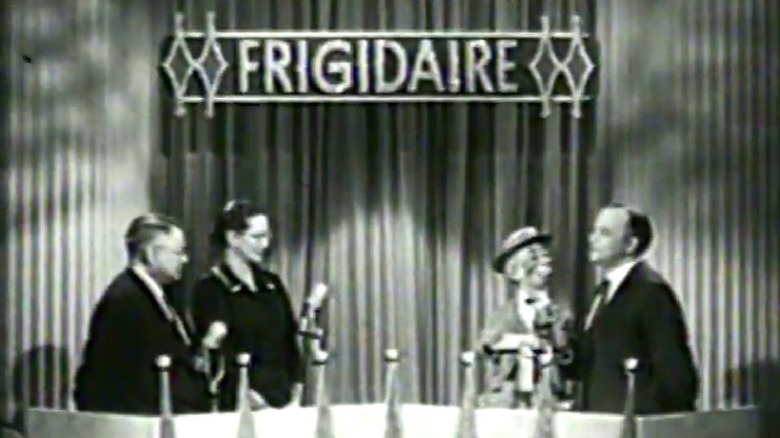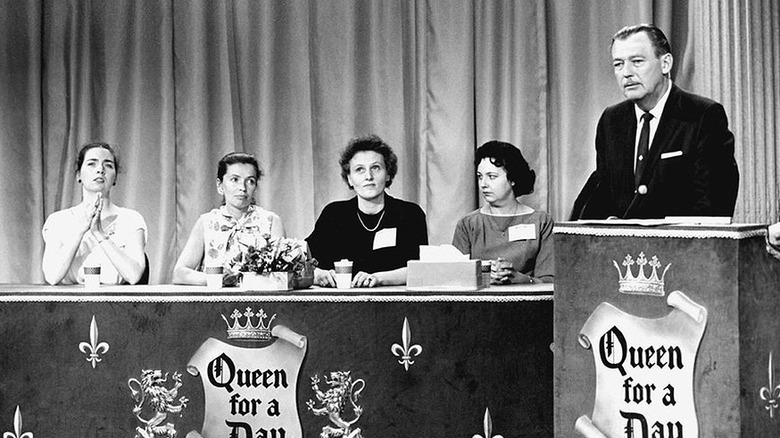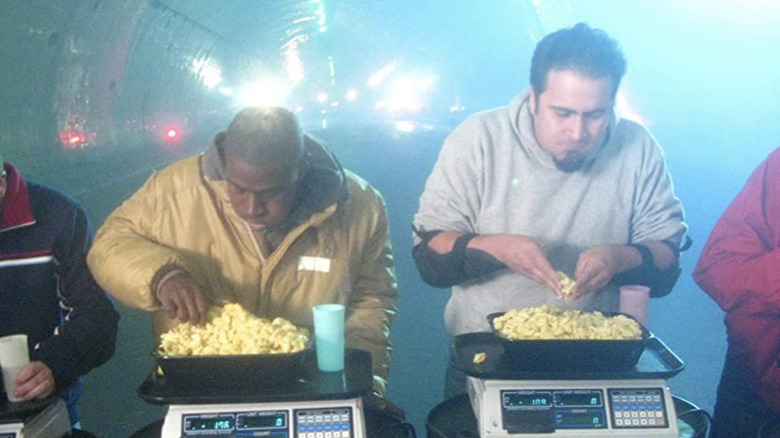Game Show Concepts That Never Should've Happened
Game shows give the viewer the chance to test their smarts in shows such as "Jeopardy!," fall in love with studio beauties on matchmaking games like "The Bachelor," or choose who gets to be the next big pop star in talent shows like "American Idol" or "America's Got Talent." But for every mainstay like "Let's Make a Deal" there are bizarre concepts, excursions in tastelessness, or otherwise bad decisions that never should have made it past the pitching stage.
Some of these shows have remained on the air longer than they should have, while others have disappeared so completely that it's near impossible to find episodes of them online. While particularly big during the reality TV craze, horrible game shows have existed from the dawn of the medium. Here's a look at some game shows that were either dangerous, disgusting, or just plain incompetent.
Dog Eat Dog (2002-2003)
Based on a UK show, the American version of "Dog Eat Dog" aired on NBC and is mostly remembered, if at all, for being hosted by former "Baywatch" star Brooke Burns. Six contestants would spend a day training with each other, and on game day players would vote on who they wanted to send to a challenge.
Among these challenges was one called Tear Factory, where contestants had to either cry through their own sad thoughts or through being berated by teammates. Another was Strip Games, where games as innocent as miniature golf and hangman included the stipulation that the contestant remove an article of clothing for each mistake. Finally, there was a segment called He or She, where six people come out and the contestant had to guess who among the group of men was actually a woman.
In what should have been a sign that maybe airing this show wasn't such a good idea, the Associated Press (via Reality TV World) reported that on the first episode contestant Darin Goka fell unconscious holding his breath during an underwater stunt. Goka claimed to have suffered brain damage and filed suit against NBC. The case was later dismissed, but regardless of this bad omen, the show went on for another season before getting canceled.
Labor Games (2015)
The miracle of birth is one of the most sacred events in a mother's life, so why not use this special time to compete for a cash prize? "Labor Games" was a show where expectant mothers were ambushed in their delivery rooms and asked to participate in a game. If they agreed, the room was transformed into a game show set, with flashing lights and a giant Labor Games sign.
One the set was unveiled, contestants were asked questions while in the throes of labor, with prizes going from a stroller all the way up to a $10,000 scholarship for the newborn child. Possibly the best thing about the show was the episode titles, which included titles such as "Cervix Says..." and "He's Ready to Slide Out of There." Host Lisa Arch responded to criticism of the show on Twitter stressing that the mothers-to-be loved being on the show, but apparently viewers weren't interested in going there, as the show only lasted for 12 episodes.
Married by America (2003)
Arranged marriages are typically frowned upon in America, but leave it to Fox to turn them into a game show. In "Married by America," a group of five men and women who'd never met before were paired up based on viewer votes. The contestants were separated by a wall so they couldn't see each other, but were allowed to talk to each other through the wall.
Not surprisingly, when the couples were paired up, chemistry never materialized, although most contestants put on a brave face and kept going for that all-important TV exposure. Beyond the premise, the show was plagued from the start: Entertainment Weekly reported that one of the contestants had already gotten married to someone else after the first episode aired. In addition, Fox was hit with a $1.18 million fine from the FCC for a scene involving strippers and whipped cream.
The show ended with a whimper, with none of the contestants getting married, so Fox wasn't even able to deliver on the premise. Given that the couples barely got along with each other and would no doubt have immediately sped off for a quick divorce after taping, perhaps this was for the best.
You're in the Picture (1961)
Some shows air a few episodes and fail, but how many air a half hour apology after a single episode? "You're in the Picture," hosted by Jackie Gleason, had a simple enough premise: Celebrity guests would stand behind giant illustrations of movie scenes or song lyrics with their heads sticking out of a hole. They would answer "yes" or "no" to Gleason's guesses, and the prizes were donated CARE packages.
The execution was a disaster, and the show received almost universally negative reviews. The response was so bad that, as chronicled in a 1961 Time article, for the second episode Gleason sat in a chair on an empty stage and spent the entire program talking about how terrible the show was, at one point bringing out one of the pictures used to demonstrate what the show was for any viewers who missed the first episode. The show ended with Gleason admitting that he had no idea what would air in its place the following week, but promised that he would be there nonetheless. (It was renamed "The Jackie Gleason Show" and lasted for another two months as a typical interview show while Gleason ran out his contract.)
Three's a Crowd (1979-1980)
Created by Chuck Barris, "Three's a Crowd" let the viewer know right away what to expect with its tagline: "Who knows a man better, his wife or his secretary?" The show seemed designed specifically to ruin marriages, with the husband being asked three questions about his wife or secretary. The wife and secretary were brought out after and each given the chance to answer the same question, and whoever's answers matched the husband's more closely won a $1,000 prize.
The backlash against the show was so severe that, according to Barris in his autobiography "The Game Show King," (Carroll & Graf, 1993) every single one of his shows was canceled in its aftermath, including "The Gong Show," "The Dating Game," and "The Newlywed Game." Barris left the television world after this failure and wrote his autobiography, "Confessions of a Dangerous Mind," which was later turned into a film by screenwriter Charlie Kaufman and directed by George Clooney, with Sam Rockwell starring as Barris.
The Biggest Loser (2004-)
The most successful show on this list, NBC's "The Biggest Loser" takes the desire to be healthy and turns it into a grueling experience where extreme dieting is combined with heavy exercise in order to maximize the amount of weight loss for each contestant. Rather than lose 1-2 pounds per week as recommended by doctors, contestants typically lose up to 10 pounds per week, with some dropping even more on their first weigh in. While health is superficially the reason why contestants are on the show, some take the competition to the extreme in order to win. According to the New York Post, first season winner Ryan Benson became so malnourished to lose weight that he started urinating blood and eventually gained back every pound he lost.
When a study was done on one of the seasons by the National Institute of Health and reported on by the New York Times, it turned out that most of the contestants had gained back all of the weight that they lost — and that their metabolism had slowed, causing some to gain even more weight. Because of the stress placed on their bodies they struggled to keep any weight off, and had to exercise harder than those at a similar weight just to maintain their size. One contestant, in an interview with Jezebel, revealed that she developed an eating disorder after being on the show. Regardless, "The Biggest Loser" remains on the air, though it now airs on the USA Network.
I Wanna Marry Harry (2014)
Hoping to recreate the gold they struck with "Joe Millionaire," Fox created "I Wanna Marry 'Harry,'" a show in which contestants would compete with each other in order to win the affection of Prince Harry of Wales — although in reality, the show's "Harry" was a lookalike named Matthew Hicks. Everything about it was a lie to the women involved; contestant Kimberly Birch, in an interview with Fusion TV, likened the show's deceitful techniques to brainwashing.
According to contestant Andrea Fox's interview with Kidd Kraddick in the Morning, the participants were initially told they were going to be on a show called Dream Date. In addition, the production crew went all in on working to convince the contestants that Hicks was Prince Harry. After dancing around his identity for the first few episodes, Hicks and his "butler" Kingsley (played by actor Paul Leonard) eventually went all in and told the contestants that he was really Prince Harry.
While eight episodes were filmed, only four ever made it to air due to low ratings, with the remainder available on Fox.com. It was a ratings disaster, but according to the New York Post, Hicks and winner Kimberly Birch maintained a friendship past the show's cancellation.
Do You Trust Your Wife? (1956-1957)
"Do You Trust Your Wife?" is a game show that operated under the premise that a woman knows less than a man, so seeing whether she can answer a question is the perfect setup for a game of risk. The show was initially hosted by ventriloquist Edgar Bergen and his most famous creation, the puppet Charlie McCarthy. Each episode would start with an interview with the couple before launching into the game proper. General knowledge questions would be posed and the husband could either answer the question himself or trust his wife to answer correctly.
Mercifully the show ditched the ventriloquist act when it came back in 1958 and added Johnny Carson as a host. The title was also changed to the less sexist "Who Do You Trust?" but the format remained the same, with a woman's knowledge still being seen as less than that of her husband.
The Chamber (2002) Fox
Controversial immediately upon airing, Fox's "The Chamber" literally placed contestants in a torture chamber where they would undergo a series of deprivations while being asked questions. The goal was not only to see who could answer the most questions correctly, but also who could endure the worst conditions for the longest amount of time. A player could volunteer to stop the chamber or could go on as far as they were able to handle it, as long as their stress quotient stayed below a Danger Zone. The game would also end if the contestant lost consciousness.
The tortures contestants endured included being blasted by punishingly high winds, going to a hot chamber where the heat was raised up to 150°F, or going to a cold chamber where the temperature would drop to below zero. There were also chambers where oxygen was lowered, electrodes were attached to contestants, and fake earthquakes raised their stress levels. According to the New York Times, had the show continued there were allegedly going to be chambers filled with insects, and contestants being electrocuted. Thankfully, it was canceled after three episodes.
Queen for a Day (1945-1964)
The oldest show on this list and the only one that started on radio, "Queen for a Day" took a superficially sweet premise — giving the less fortunate what they desperately need — and turned it into a competition among contestants to see who had the worst life. Many contestants needed medical care or help paying their bills and would end up crying. This would be followed by the audience picking the winner via an applause meter.
The worse the person's story was, the louder the applause. The winner would then be given a robe and crown, sat on a throne and given roses while "Pomp and Circumstance" played. All contestants received a prize, but the winner would get the help they requested, along with other prizes donated by sponsors.
"Queen for a Day" remains an outstanding example of TV cashing in on misery for ratings. The entire business feels distasteful, especially the sight of an audience clapping for tragedy.
Hurl! (2008)
The game show equivalent of "Jackass," "Hurl!" combined the sport of competitive eating with the fun of intense carnival rides. On "Hurl!," throwing up was encouraged — the winner was the contestant who made it to the end of the show without vomiting, with the prize being a measly $1,000. According to an LA Weekly review, the show was clear about what did and did not qualify as vomiting: If a contestant threw up in their mouth but nothing came out, it didn't count and they could stay in the game. There were also multiple rounds — contestants would eat, perform an activity, and if they didn't throw up they would eat again. This went on for three rounds, and the winner was allowed to throw up after receiving their cash prize, which obviously would be shown on the air.
Thankfully, the episodes were censored with numbered buckets covering the vomit and sound effects. Eleven episodes in all were made, and with this concept it's amazing that they all aired.
Distraction (2003-2004)
The British series "Distraction" was another endurance test of a game, with contestants having to answer questions while dealing with a number of distractions. These could be as innocent as contestants putting clothespins on their face while answering a question, or as extreme as being body slammed or getting electrocuted by a dog collar. The show also included tickle torture, being shot with a paintball gun, or eating something disgusting such as a lamb testicle. Contestants also had to do uncomfortable things to buzz in to answer a question, such as drink a shot of hot sauce or urinate in a specific toilet.
The show lasted for two seasons and even had a tie-in book which included questions from the show along with pictures of some of the distractions. Most surprising of all is that there were international versions of the series, and the United States did not have their own version. Given what we were airing here, it's somewhat surprising that US stations didn't feel the need to import "Distraction."
Who's Your Daddy? (2005)
A concept that would give even Maury Povich pause, Fox's "Who's Your Daddy?" put an adopted adult in a room full of eight men. The contestant then had to figure out which of these strangers was their biological father; if she guessed correctly, she won $100,000, but in a cruel twist, if she picked the wrong man, then he got the money instead. Six episodes were filmed, with six different women seeking their fathers, but only one 90-minute episode aired.
The show was controversial immediately upon release, with adoption agencies and parents calling the network and demanding it be pulled from the air, according to Today. At least one network affiliate removed it from the schedule, though executive producers Scott Hallock and Kevin Healey, in an interview with the Sydney Morning Herald, maintained that show had "its heart in the right place." Even by reality TV standards, turning adoption into a game with a cash prize was low.
The Swan (2004)
The nadir of the reality TV game show boom of the 2000s and frequently cited as the worst game show ever made, Fox's "The Swan" took a group of women and spent three months putting them on diets, giving them makeovers, and — most notoriously — giving them numerous plastic surgeries. The contestants were not allowed to look in a mirror during the entire process, and interviews were conducted with their spouses, which, according to "Swan" writer Rebecca Hertz in an interview for Entertainment Weekly, were edited to make them sound as cruel as possible regarding their looks. After it was all over, contestants would compete in a beauty contest and possibly become a spokesperson for a corporate sponsor.
According to the New York Post, many of the contestants on this show later divorced; one contestant said that she endured major weight gain and agoraphobia which left her unable to enjoy her life. Amazingly, "The Swan" rode the controversy to a second season, with 18 episodes in total being produced before the show was canceled.


